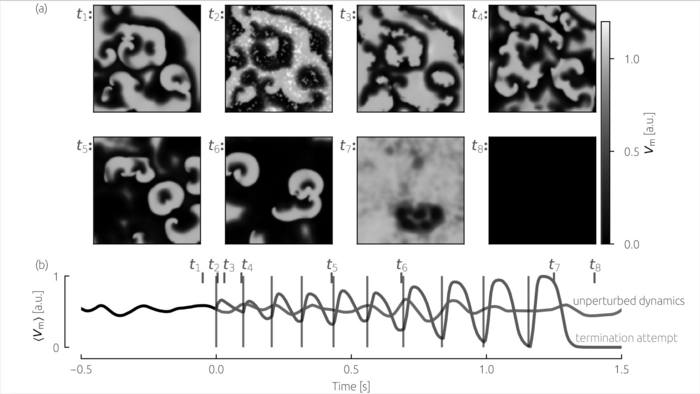WASHINGTON, Dec. 13, 2022 – Atrial and ventricular fibrillations are dangerous heart arrhythmias that claim millions of lives each year. Current treatment for them is a high-energy defibrillation shock that can be intensely painful and lead to further heart damage. New work applying principles from nonlinear dynamics looks to find ways to reset the heart with fewer side effects.

Credit: Thomas Lilienkamp
WASHINGTON, Dec. 13, 2022 – Atrial and ventricular fibrillations are dangerous heart arrhythmias that claim millions of lives each year. Current treatment for them is a high-energy defibrillation shock that can be intensely painful and lead to further heart damage. New work applying principles from nonlinear dynamics looks to find ways to reset the heart with fewer side effects.
With numerical simulations, researchers from the Max Planck Institute for Dynamics and Self-Organization, German Center for Cardiovascular Research, Georg-August-Universitӓt Gӧttingen, and University Medical Center Gӧttingen have demonstrated a new way to time weak electrical pulses that can stop certain life-threatening arrhythmias. Publishing their work in Chaos, by AIP Publishing, the group shows that timed pulses are successful in ending atrial and ventricular fibrillations.
The study provides early evidence that one theorized approach to controlling fibrillations – adaptive deceleration pacing – can improve the performance of defibrillators.
“In numerical simulations, we investigate how the dynamics of chaotic electrical excitation waves, which govern the dynamics of the heart during fibrillations, can be controlled more efficiently,” said author Thomas Lilienkamp. “Our goal is to use numerical simulations to find control strategies that avoid the application of high-energy shocks and that can also be tested in experimental setups and eventually on patients to reduce side effects.”
Adaptive deceleration pacing uses a series of weak pulses that are spaced farther apart over time to respond to the heart and return it to a normal rhythm in a few beats.
“With our approach, we can develop a pulse sequence specifically designed for a specific patient and even for a specific arrhythmia,” Lilienkamp said. “This can be crucial, since even two arrhythmias in the same patient can be different in terms of the underlying dynamics characterized.”
After starting a chaotic spiral wave form that is characteristic of the arrhythmias in four different heart models, the authors tested their approach using different pulse pacing sequences. The high-dimensional complexity of the dynamics and its dependence on control parameters makes numerical simulations a useful tool for handling such a high volume of calculations.
“In order to investigate and compare the performance of different pulse sequences, a large number of numerical simulations is required. The success rate we use as a benchmark for a specific pulse sequence is a statistical quantity averaged over the result of many single simulations,” Lilienkamp said.
Adapting the rate of deceleration to the spectrum of electrical signal frequencies in the simulated cardiac tissue significantly increased the success rate of stopping arrhythmias with relatively weak pulses. To boot, the adaptive deceleration pacing doesn’t require a sophisticated set of control parameters, showing promise for use in future defibrillators.
The group hopes to continue its work in more complex models and in experimental setups with real cardiac tissue.
###
The article “Taming cardiac arrhythmias: Terminating spiral wave chaos by adaptive deceleration pacing” is authored by Thomas Lilienkamp, Ulrich Parlitz, and Stefan Luther. The article will appear in Chaos on Dec. 13, 2022 (DOI: 10.1063/5.0126682). After that date, it can be accessed at https://doi.org/10.1063/5.0126682.
ABOUT THE JOURNAL
Chaos is devoted to increasing the understanding of nonlinear phenomena in all areas of science and engineering and describing their manifestations in a manner comprehensible to researchers from a broad spectrum of disciplines. See https://aip.scitation.org/journal/cha.
###
Journal
Chaos An Interdisciplinary Journal of Nonlinear Science
DOI
10.1063/5.0126682
Article Title
Taming cardiac arrhythmias: Terminating spiral wave chaos by adaptive deceleration pacing
Article Publication Date
13-Dec-2022




